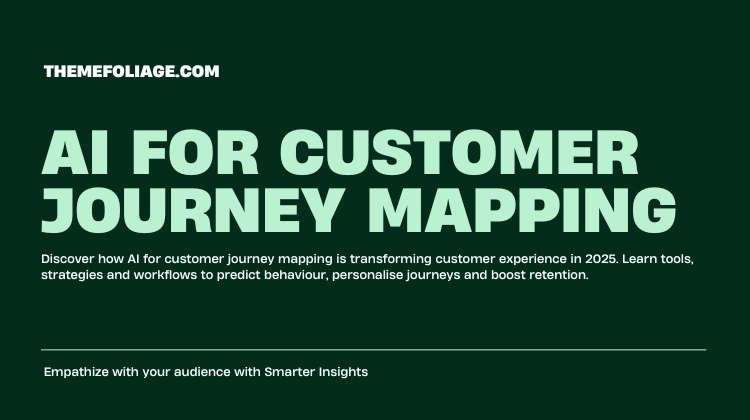In 2025, customer expectations are higher than ever. They want seamless, personalised experiences across every channel web, mobile, email, social, and even offline. To deliver this, businesses are turning to AI for customer journey mapping.
Customer journey mapping has always been a strategic tool for visualising the end‑to‑end experience. But traditional maps are static, often outdated the moment they’re created. AI changes this by making journey maps dynamic, predictive and actionable.
According to SuperAGI, 80% of companies now recognise customer journey mapping as a crucial strategy to enhance satisfaction and reduce service costs, with some reporting a 20–30% boost in retention when using AI‑powered tools.
What Is AI‑Powered Customer Journey Mapping?
Traditional journey maps are built on assumptions, surveys and workshops. They’re useful, but limited. AI‑powered journey mapping, by contrast, uses machine learning, natural language processing and predictive analytics to:
- Analyse vast amounts of customer data in real time
- Identify behavioural patterns and intent signals
- Predict future actions and churn risks
- Personalise journeys dynamically across channels
As Miro explains, “Imagine if your customer journey map was a living, breathing entity—showing not just where your customers have been, but where they’re going next.”
Why AI Matters for Customer Journey Mapping
- Dynamic Insights: AI maps update continuously as new data flows in, unlike static maps that quickly become outdated.
- Predictive Capabilities: AI forecasts customer behaviour—who’s likely to churn, who’s ready to upgrade, who needs nurturing.
- Personalisation at Scale: AI tailors journeys for each customer segment, or even individuals, based on real‑time signals.
- Cross‑Channel Integration: AI unifies data from web, mobile, CRM, call centres and social media into a single journey view.
- Actionable Recommendations: AI doesn’t just show the journey—it suggests next best actions to improve outcomes.
Key Applications of AI in Customer Journey Mapping
1. Predictive Churn Analysis
AI models identify customers at risk of leaving by analysing engagement drops, support tickets or inactivity. Marketers can then trigger retention campaigns.
2. Next‑Best‑Action Recommendations
AI suggests personalised offers, content or outreach at each stage of the journey. For example, recommending a discount to a hesitant shopper or a premium upgrade to a loyal subscriber.
3. Sentiment Analysis
Natural language processing analyses reviews, chat transcripts and social mentions to gauge customer sentiment and feed insights into the journey map.
4. Omnichannel Orchestration
AI ensures consistent messaging across email, SMS, push notifications and in‑store experiences, adapting in real time.
5. Journey Simulation
AI can simulate customer journeys before campaigns launch, predicting bottlenecks and outcomes.
Recommended AI Tools for Customer Journey Mapping (2025)
Note: Prices may change depending on provider updates.
| Tool | Function | Pricing (USD) |
|---|---|---|
| Salesforce Einstein | Predictive analytics & journey orchestration | From $25/user/month |
| Adobe Journey Optimizer | Omnichannel journey mapping & personalisation | Custom pricing |
| Miro AI | Collaborative journey mapping & templates | Free plan; Pro from $10/month |
| Optimove | Predictive churn modelling & retention | From $500/month |
| Thunderhead (Medallia) | Real‑time journey orchestration | Custom pricing |
| Pointillist | Customer journey analytics & attribution | From $1000/month |
| Zoho CRM Plus | AI‑driven journey insights for SMBs | From $57/user/month |
Real‑World Example
A telecom company used Optimove and Salesforce Einstein to map customer journeys across call centres, mobile apps and billing systems. AI identified that customers who contacted support twice in a month were 60% more likely to churn.
By proactively offering discounts and personalised support, the company reduced churn by 18% and increased customer lifetime value by 22% within six months.
How to Implement AI‑Powered Journey Mapping
- Audit Your Data Sources: Consolidate data from CRM, analytics, support and social platforms.
- Define Key Stages: Map awareness, consideration, purchase, onboarding, retention and advocacy.
- Select AI Tools: Choose platforms that integrate with your existing stack (Salesforce, Adobe, Zoho).
- Train Predictive Models: Use historical data to train AI on churn, upsell and engagement patterns.
- Automate Next‑Best Actions: Configure AI to trigger personalised campaigns based on journey stage.
- Monitor and Refine: Review journey analytics monthly. Adjust models and campaigns based on performance.
Challenges and Considerations
- Data Silos: AI is only as good as the data it has. Break down silos for a unified view.
- Privacy Compliance: Ensure GDPR/CCPA compliance when using behavioural data.
- Over‑Automation: Balance AI efficiency with human empathy and creativity.
- Integration Complexity: Some tools require technical setup—choose platforms with strong APIs.
Future of AI in Customer Journey Mapping
By 2025 and beyond, AI will not only map journeys but also simulate outcomes before campaigns launch. Imagine testing a new onboarding flow virtually and seeing predicted retention rates before rolling it out.
We’ll also see more real‑time personalisation, where every touchpoint—ads, emails, support chats—adapts instantly to customer behaviour.
The global customer experience management market is projected to reach $14.9 billion by 2025, underscoring the importance of AI‑driven journey mapping.
Final Thoughts
AI for customer journey mapping is no longer optional, it’s essential. By predicting behaviour, personalising experiences and orchestrating journeys across channels, AI empowers businesses to deliver seamless, engaging and profitable customer experiences.
Start small with one journey, such as onboarding or retention, and expand as you gain insights. The brands that thrive in 2025 will be those that treat journey mapping not as a static diagram, but as a living, AI‑powered system.



